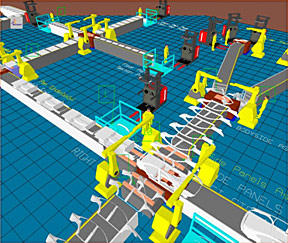NIST-Led Standard Enables Agility, Cost and Time Savings

Thanks to a successful long-term NIST-led collaboration, modeling and simulation capabilities will become more practical and cost-effective for a much broader spectrum of U.S. manufacturers. This will enable firms, large and small, to trim product-development times, save resources, improve efficiency, and avoid costly trial-and-error implementations on the factory floor.
Evaluating new processes, material substitutions, and other potential tweaks to production systems on a computer—in the virtual world, rather than the real world—can save manufacturers lots of time and money. Reliable modeling and simulation tools also can inspire new ways of thinking about production operations without requiring major investments of resources in prototype implementations.
Too often, unfortunately, these promising benefits are undermined by the substantial difficulty and cost of integrating the necessary input data into the simulations. The data typically resides in separate files or databases, often in incompatible formats. In fact, inputting and managing data can account for up to 40 percent of the time invested in a simulation project. Furthermore, once a project is completed there is no straight forward means to update the data or to transfer it for use in another simulation.
The Core Manufacturing Simulation Data (CMSD) specification (SISO-STD-008-2010) eliminates much of the tedium and many of the logistical obstacles that have impeded effective, widespread use of simulation tools in manufacturing. Under the umbrella of the Simulation Interoperability Standards Organization, NIST spearheaded the development of CMSD, an open source standard that enables engineers to, consistently and unambiguously, import and export many different types of factory data into computer simulations.
An important feature that differentiates CMSD from other standards for manufacturing software is that it accommodates information about variability in production. Understanding variability, such as seasonal changes in orders for products, is key for effectively analyzing and carrying out production.
By enabling the specification and exchange of process variability information, CMSD can greatly reduce the time and effort needed to construct realistic simulation scenarios to support decisions on how to improve operations.
Draft versions of the specification underwent rigorous testing in systems supporting the analysis of actual manufacturing facilities involving car, truck, and aircraft production operations. The resulting, "battle-tested" final version of CMSD, according to a recent assessment, "holds a large potential for facilitating interoperability between simulations systems and other information systems."
This potential already is being realized. The CMSD standard is being implemented in software tools by the Connecticut Center for Advanced Technology. The software eliminates much of the repetitive, time-consuming work of translating and inputting manufacturing data, so simulation experts and plant managers work on the more important details of building a model of their processes. For example, using the CMSD standard, the center developed a tool that extracted "value stream map" information created with eVSM, an off-the-shelf software used by more than 10,000 manufacturing customers, and used that information to automatically generate simulations of the associated manufacturing and business processes for further analysis.
"The CMSD standard," says Bill Waite, Chairman and Chief Technical Officer of AEgis Technologies, "will speed the construction of manufacturing simulators. Ultimately, increased use of modeling and simulation technology in all phases of the manufacturing life-cycle will significantly accelerate productivity and thereby improve economic well-being so strongly dependent on that economic sector."

